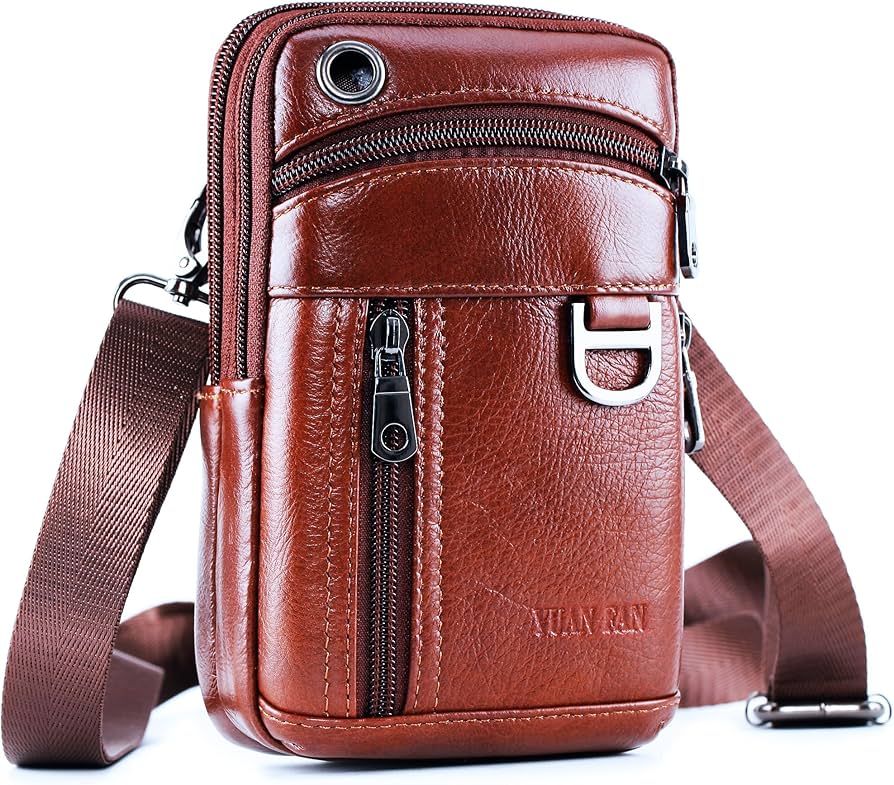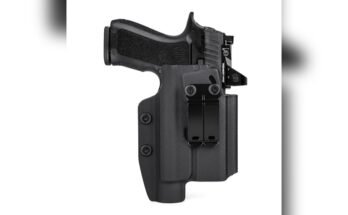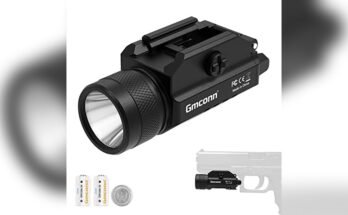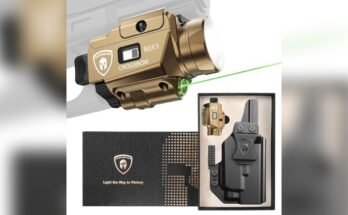If you’ve ever asked, what materials are holsters made of?, you’re in the right place. I’ve tested leather, Kydex, nylon, and more in daily carry, long training days, and road trips. Each material changes how a holster feels, lasts, and performs. In this guide, I’ll break down your options in clear, simple terms so you can pick the right fit with confidence.

Source: www.ebay.com
Holster Materials At A Glance
Picking a holster is not just about the gun. It’s about the material touching your body, clothing, and gear. The big three are leather, Kydex, and nylon. You’ll also see hybrid holsters that blend two or more.
Here is the quick view:
- Leather offers comfort and a custom feel over time.
- Kydex and other thermoplastics give shape, speed, and firm retention.
- Nylon and fabric are light, soft, and budget-friendly.
- Hybrid holsters combine soft backers with hard shells.
- Specialty materials like Boltaron, carbon fiber, and neoprene add niche perks.
Your choice affects comfort, concealment, retention, and care. If you carry daily, material choice is a big deal.

Source: www.amazon.com
Leather: Classic Feel And Fit
Leather is the old-school standard. It molds to your gun and your body with use. Good leather feels smooth and warm, and it spreads pressure well on the hip.
What to love:
- Comfortable once broken in
- Quiet on the draw and reholster
- Timeless look with strong durability
What to watch:
- Needs care with oil or conditioner
- Can soften and lose retention over years
- Sensitive to sweat and heavy rain if untreated
Real-world tip: I carry leather in cool weather when sweat is low. It hugs the body under a sweater and stays quiet. For faster draws in classes, I switch to Kydex for crisp retention.

Source: www.ebay.com
Kydex And Thermoplastics: Shape And Speed
Kydex is a hard thermoplastic. It is heat-formed to the exact shape of your gun. It clicks in with clear retention and allows a fast, smooth draw.
What to love:
- Consistent retention with that audible click
- Great for training and timed drills
- Low maintenance and sweat-resistant
- Keeps its shape for clean reholstering
What to watch:
- Can feel stiff or sharp on the edges if not finished well
- Can print more if the design is bulky
- Louder than leather or fabric
Practical note: I tighten or loosen the retention screws at the start of each season. Screws can back out over time. A tiny drop of thread locker helps.

Source: www.amazon.com
Boltaron And Injection-Molded Polymers
Boltaron is another thermoplastic, similar to Kydex. It can handle heat and cold very well. Some users find it slightly tougher around edges and cracks.
Injection-molded polymer holsters are built in molds for high consistency. Many duty and duty-style holsters use them for rugged strength and retention systems.
What to love:
- Stable in temperature swings
- Strong, predictable fit
- Common on duty holsters with level 2 or 3 retention
What to watch:
- Less custom fit than hand-formed Kydex
- Bulkier designs can affect concealment
Use case: If you live in very hot or cold climates, Boltaron and injection-molded options hold up well. They resist warping on hot dashboards or cold winter nights.

Source: www.ebay.com
Nylon And Fabric Holsters
Nylon holsters, often made with Cordura or similar fabrics, are light and soft. They can be good for range bags, backup use, or casual carry.
What to love:
- Very comfortable and low-cost
- Light and flexible
- Gentle on skin and clothing
What to watch:
- Often less precise retention
- Can collapse when empty, making reholstering slower
- Stitching and Velcro can wear faster
Honest take: I use nylon for hiking with small pistols where weight matters. For daily concealed carry, I prefer something with a more defined fit.

Source: www.amazon.com
Hybrid Holsters And Backers
Hybrid holsters pair a rigid shell with a soft backer. The shell is usually Kydex or Boltaron. The backer can be leather, neoprene, or a breathable synthetic.
What to love:
- Comfort of soft backing against the body
- Strong retention from the hard shell
- Good for long days of carry
What to watch:
- Sweat can soak the backer if not breathable
- Hardware needs routine checks
- Larger footprint than some all-Kydex rigs
Personal tip: In summer, I use a hybrid with a ventilated backer. It spreads weight well and reduces hot spots. I check the mounting screws every few weeks.

Source: www.amazon.com
Specialty Materials: Carbon Fiber, Suede, Neoprene
Some holsters use specialty materials or finishes to solve specific problems.
- Carbon fiber or carbon-look: Light and stiff. Often a finish over polymer. Good for minimal flex and a premium feel.
- Suede liners: Softer on finishes. Helps reduce scuffing on polished slides.
- Neoprene: Soft, cushioned, and sweat-friendly. Often used in hybrid backers.
- Microfiber or air-mesh backers: Increase airflow and comfort in heat.
- Foam layers (EVA): Add cushion while keeping shape.
These features raise comfort or protect finishes, but they can add cost and thickness. If you want comfort above all, a neoprene or mesh backer is hard to beat.

Source: www.ebay.com
How Material Affects Comfort, Retention, And Wear
Think of material as the DNA of a holster. It drives the feel, the grip on the gun, and how it ages.
- Comfort: Soft backers spread pressure. Leather warms and forms to you. Kydex is firm but stable.
- Retention: Kydex and polymers use shape and friction. Leather uses fit and tension. Duty holsters add locks and hoods.
- Draw speed: Rigid shells keep a clear mouth for fast draws. Soft holsters can collapse and slow reholster.
- Finish wear: Hard shells can scuff high spots over time. Suede liners help, but carbon steel finishes need care.
- Noise: Leather and fabric are quiet. Kydex gives a click on draw and reholster.
Lesson learned: Comfort is king for daily carry. If it hurts or rubs, you will not wear it. Choose the one you will actually use every day.
Climate, Care, And Lifespan
Weather and care are big factors in how long a holster lasts.
- Heat: Cars get hot. Kydex and Boltaron hold shape, but do not leave them pressed under weight.
- Cold: Boltaron can be a bit more stable than Kydex in deep cold. Leather stiffens in winter and may need a short break-in again.
- Sweat: Leather needs treatment to resist moisture. Neoprene and mesh backers handle sweat better.
- Maintenance: Check screws and clips. Wipe dust and lint out of Kydex shells. Clean leather with proper products, not harsh cleaners.
- Lifespan: Quality leather and polymer holsters can last many years with care. Budget nylon may show wear sooner.
I keep a small holster kit: thread locker, extra screws, a cloth, and conditioner. Ten minutes of care can add years of use.
Choosing The Right Material For Your Use Case
Match the holster to your daily life. Here is a simple path to decide.
- For concealed carry, all-day comfort: Hybrid with breathable backer or well-finished leather.
- For training and speed: Kydex or Boltaron with adjustable retention.
- For harsh climates: Boltaron or injection-molded duty-grade polymer.
- For tight budgets and light use: Nylon or simple Kydex.
- For finish protection: Leather with a suede liner or a lined polymer shell.
- For minimal printing: Thin Kydex designs with claw attachments.
Fit matters more than brand. Test at home with safe handling. Try different belts and positions like appendix or strong-side. Small tweaks change comfort and concealment a lot.
Frequently Asked Questions Of What materials are holsters made of?
Are Leather Holsters Still A Good Choice Today?
Yes. Quality leather is comfortable, quiet, and durable. It needs some care and can soften over time, but many users love the custom fit it develops.
What Is The Difference Between Kydex And Boltaron?
Both are thermoplastics. Boltaron tends to handle extreme temperatures a bit better. Kydex is very common and offers sharp definition. Both provide crisp retention.
Do Nylon Holsters Hold Up For Daily Carry?
They can, but they wear faster than leather or polymer. They are light and soft, but often lack firm retention. They are great for light use, hiking, or as a backup option.
What Is A Hybrid Holster?
A hybrid combines a rigid shell, usually Kydex, with a soft backer like leather or neoprene. The goal is to blend comfort and secure retention.
Will A Kydex Holster Scratch My Gun?
Any rigid holster can cause finish wear at high contact points over time. A smooth interior, clean holster, and occasional wipe-down help reduce marks.
How Do I Maintain Leather Versus Kydex?
Leather needs gentle cleaning and conditioner. Keep it dry and away from harsh heat. Kydex needs only a quick wipe to clear dust and lint, plus a check on screws.
What Material Is Best For Hot Weather?
Breathable hybrid backers, neoprene, or slim Kydex designs tend to be cooler. They handle sweat better and keep their shape.
Conclusion
The best answer to what materials are holsters made of? is that each brings trade-offs. Leather gives comfort and tradition. Kydex and Boltaron give speed and consistency. Nylon gives light weight and value. Hybrids aim for the sweet spot in daily carry.
Try what matches your climate, body shape, and routine. Start with comfort and retention. Keep it clean and check the hardware. Small steps will make carrying safer and easier.
Ready to go deeper? Explore more guides, subscribe for updates, or ask your questions in the comments. Your next holster could be the one you actually wear every day.
Watch This Video on What materials are holsters made of?



